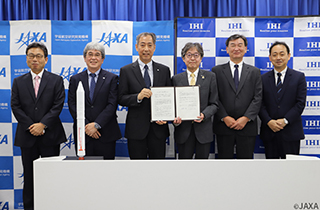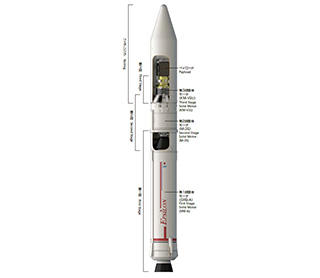About Epsilon Launch Vehicle
 |
The Epsilon Launch Vehicle is a solid-fuel rocket designed to lower the threshold to space hitherto regarded as “special” and to usher in an age in which everyone can make active use of space. It has achieved a world-class, satellite-friendly environment by reducing vibration and noise as well as buffering shocks during satellite separation. Epsilon-4 established the technology for the simultaneous launch of multiple satellites, and Epsilon-5 succeeded in inserting nine satellites, the most ever, into their scheduled orbit. Furthermore, the development of the “Epsilon S Launch Vehicle” has started to strengthen Epsilon's international competitiveness by maximizing synergistic effects with the H3 Launch Vehicle with the aim at launching the demonstration flight in FY2023. Through these efforts, we intend to make a full-scale enter into the launch market for small satellites including nanosatellites, the demand for which is expected to grow in the future. |
|---|
Compact Launch System
|
Epsilon's automated inspection and its small, simple launch pad are key elements for our compact launch system. |
From experimental models to enhanced launch vehicles
|
Technologies from the H-IIA and M-V rockets were carried over to save time and cut development costs. M-V launch control operations were revamped and mobile control introduced to renovate the operational and equipment dimensions of rocket launch procedures. Following the successful launch of an experimental model, further improvements were undertaken to optimize rocket airframe performance. These enhancements were completed with Epsilon-2 and Epsilon-3. Epsilon-4 featured a simultaneous launch of multiple satellites, establishing the technology for accurately inserting individual satellites into their respective orbits. This technology was developed to make the Epsilon Launch Vehicle internationally competitive in the launch market for mini-/micro-satellites and CubeSats, where demand is expected to expand globally. |
 |
|---|
From enhanced launch vehicles to Epsilon S
|
Technological advances in miniaturization and integration have spurred launch demand for mini-/micro-satellites and CubeSats in satellite launch markets inside and outside Japan. Created to meet this demand, the new “Epsilon S Launch Vehicle Project” aims to expand the scale of Japan’s space transport industry by transferring the Epsilon Launch Vehicle program to the private sector and developing it into an autonomous and sustainable transport system. An Epsilon S demonstration launch is tentatively scheduled for FY2023. |
Project Topics
indexSigning of the “Basic Agreement on the Development of the Epsilon S Launch Vehicle and the Implementation of the Launch Service Business”

|
The Japan Aerospace Exploration Agency (JAXA) is pleased to announce that it has entered into the Basic Agreement with IHI AEROSPACE CO., LTD. (IA) on the development of the Epsilon S Launch Vehicle and its launch service business. The Epsilon S Launch Vehicle, which will be developed based on the current Enhanced Epsilon, is aimed at strengthening Epsilon’s international competitiveness in the satellite launch market by achieving synergist... |
|---|
Press Release
index-
- Apr. 7, 2023 (16:00) [release]
- RApid Innovative payload demonstration SatellitE-2(RAISE-2)Ends Its Operation
Characteristics of Epsilon Launch Vehicle
Major Characteristics
Epsilon Major Characteristics
| Test Flight Model | Enhanced Model | |
|---|---|---|
| Length (m) | 24 | 26 |
| Mass (t) | 91 | 95.4 |
| Diameter (m) | 2.6 | |
Epsilon Launch Vehicle Launch Capacity
| Specifications | Standard Configuration Three-staged Solid Propellant Launch Vehicle |
Optional Configuration Three-staged Solid Propellant Launch Vehicle + Compact Liquid Propulsion System |
|---|---|---|
| Low Earth Orbit (LEO) | 1200kg (Perigee 250km x Apogee 500km) |
700kg (500km circle) |
| Sun-Synchronous Orbit (SSO) | - | 450kg (500km circle) |
Launch Records
| Flight No. | Launch Date | Payload |
|---|---|---|
| Epsilon-4 | 1/18/2019 | The Innovative Satellite Technology Demonstoration-1 |
| Epsilon-3 | 1/18/2018 | NEC Small radar satellite "ASNARO-2" |
| Epsilon-2 | 12/20/2016 | Exploration of energization and Radiation in Geospace "ARASE" (ERG) |
| Epsilon-1 | 9/14/2013 | Spectroscopic Planet Observatory for Recognition of Interaction of Atmosphere "HISAKI" (SPRINT-A) |
Mission talk by team leaders
 |
Project Manager Yasuhiro MoritaHere are messages from Project Managers. |
|---|



